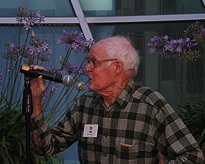Oliver Payne Pearson facts for kids
Quick facts for kids
Oliver P. Pearson
|
|
|---|---|

June 2001
|
|
| Born |
Oliver Payne Pearson
October 21, 1915 |
| Died | March 4, 2003 (aged 87) |
| Nationality | American |
| Alma mater | Harvard University |
| Known for | The rate of metabolism of some small mammals. Ecology 28:127-145 (1947). |
| Awards | Hartley H. T. Jackson Award (1984), Honorary Doctoral Degree, University of La Plata (2000) |
| Scientific career | |
| Fields | Mammalogy, Ecology |
| Institutions | UC Berkeley, Museum of Vertebrate Zoology |
| Author abbrev. (zoology) | Pearson |
Oliver Payne Pearson (born October 21, 1915, died March 4, 2003) was an American scientist. He was a zoologist, studying animals, and an ecologist, studying how living things interact with their environment. People often called him "Paynie."
For over 50 years, he worked as a professor at the UC Berkeley. He was also a curator of mammals at the Museum of Vertebrate Zoology. Pearson was famous for his research on small mammals like voles. He studied how predators affected their populations. He also made important discoveries about mammals in South America.
Contents
Oliver Pearson's Early Life and Education
Oliver Pearson was born in Philadelphia, Pennsylvania. He went to Swarthmore College and graduated in 1937. After that, he studied at Harvard University. He earned both his master's degree (M.S.) in 1939 and his Ph.D. in 1947 from Harvard.
Starting His Career at UC Berkeley
In 1947, Pearson joined UC Berkeley as an instructor in zoology. He quickly became an assistant professor and assistant curator of mammals in 1949. By 1955, he was a full associate professor and associate curator.
Focusing on Research
In 1957, he decided to step back from his full-time teaching role. This allowed him to spend more time on his research. He focused on studying voles and how predators affected them. During this time, he also spent a year teaching in Argentina. He was a visiting professor of ecology at the University of Buenos Aires.
Leading the Museum
Pearson returned to UC Berkeley in 1965. He became a full professor of zoology. From 1967 to 1971, he served as the director of the Museum of Vertebrate Zoology. He retired in 1971 but remained very active in his field.
Exploring South American Mammals
Oliver Pearson was very interested in the animals of South America. He traveled there many times throughout his career.
Travels and Research
His first trip was to Panama in 1937. He then visited Peru multiple times between 1938 and 1972. He also traveled to Colombia in 1950 and Argentina many times. From 1978 to 1999, he visited Argentina every year to continue his research.
Awards and Honors
Pearson was an honorary member of several important scientific groups. These included the American Society of Mammalogists (ASM) and the Cooper Ornithological Society (COS). He also received the Hartley H. T. Jackson Award in 1984. This award recognized his long and excellent service to the ASM.
After he passed away in 2003, the ASM created a special award in his honor. The Oliver Pearson Award helps young scientists in Latin America. It gives them money to start or continue their research on mammals.
Oliver Pearson's Family Life
In 1944, Oliver Pearson married Anita Kelley. She was his partner and traveled with him on all his research trips. They had four children together.
In 2000, Pearson received an honorary doctoral degree from the University of La Plata in Argentina. During his acceptance speech, he famously said, "I am a simple mouse-trapper, and nothing would have been possible without Anita." This showed how much he appreciated his wife's support.
Animals Named After Oliver Pearson
Oliver Pearson's work was so important that three types of rodents were named after him. This is a special way to honor scientists.
- The species Ctenomys pearsoni
- The species Andalgalomys pearsoni
- The genus Pearsonomys
See also
 In Spanish: Oliver Paynie Pearson para niños
In Spanish: Oliver Paynie Pearson para niños

